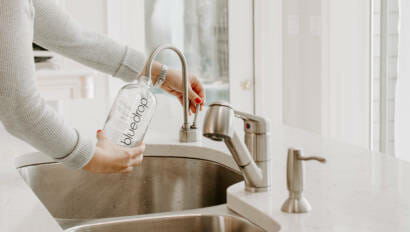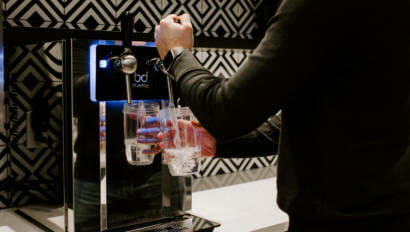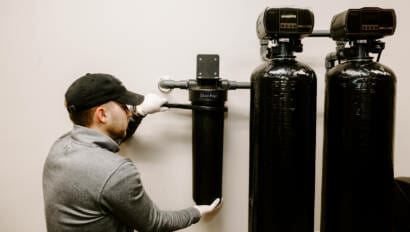Reverse osmosis, often referred to as RO, is an advanced water purification method that was initially developed by the U.S. Navy to produce drinking water from sea water for submarine crews.
It is a membrane filtration technology that works by forcing water under pressure through the very tiny pores of a semi-permeable membrane. Modern reverse osmosis units for the home combine membrane technology with carbon and mechanical filtration to produce highly purified, great-tasting water.
Water, driven by the home’s water pressure, flows first through a sediment filter and carbon pre-filters removing dirt, debris and organic contaminants including chlorine and its by-products.
Next, it enters the reverse osmosis membrane, a very tight, sheet-like filter, that allows water to pass but rejects dissolved solids like sodium and impurities such as lead and arsenic.
The purified water is stored in a small storage tank until it is needed. When the countertop faucet mounted on the sink is opened, purified water is forced by air pressure through a post-carbon filter, which provides a final polish as water travels towards your faucet.
Both effectively reduce “dissolved solids” content of water, but the processes are quite different.
RO filters water through a very tight semi-permeable membrane. A distiller is like a big tea kettle: it boils water, catches the steam, condenses it, and captures the resulting water. Most impurities are left behind in the boiling chamber.
Both distillers and reverse osmosis systems rely heavily on carbon filtration for chemical removal. (Cheap distillers often have little or no carbon filtration and are, therefore, of limited effectiveness.)
Distillers typically remove a few parts per million more of common mineral constituents like sodium.
However, distillers don’t do a good job with volatile chemicals with a low boiling point. Chloramines, for example, which many cities now use instead of chlorine as a disinfectant, aren’t removed well by distillers.
Reverse osmosis, with the carbon filters that accompany it, does a very good job with chloramines. Unless volatile chemicals like chlorine are removed by carbon filtration before they enter the distiller, they will be released into the room air or they will end up in the distilled water.
But in general, distilled water is very pure, as is reverse osmosis water.
It depends on what you mean by waste. A residential RO unit uses water to clean itself and wash away impurities. It’s like a lot of other water-using appliances. We use water to wash clothes, to wash dishes, to wash cars, to flush toilets.
A reverse osmosis unit uses more water in its operation than you actually consume, but it doesn’t use enough that it would be noticed it on your water bill. It uses water only while it’s filling its storage tank. When the tank is full, the whole unit shuts down and no water runs to drain.
Virtually forever if professionally serviced each year. Typical membrane life is about 3 to 5 years, depending on the nature of the water that it’s processing, and typical filter life is 12 months. Each year during Bluedrop’s preventative maintenance visit, all four filters are replaced, and the reverse osmosis membrane is tested.
It’s true that RO units remove up to 95% of the mineral content in water. With that said, minerals in water are inorganic and difficult for your body to use. Human’s get most of our minerals from food, which provides organic, easily assimilated minerals. The main issue with water is chemicals, not minerals. Whether water contains 30 or 3 parts per million calcium isn’t really significant, but 5 parts per million of a dangerous chemical can be a serious health concern. Bluedrop can provide remineralization filters for customers who prefer a higher mineral content water, or for customers with low-pH water issues.
No, a standard Bluedrop RO system (such as the BDRO-50) runs on water pressure. You only need electricity if you add an electric pressure-boost pump or an ultraviolet lamp. Standard Bluedrop RO systems have neither and don’t require a power source.
Because they produce great-tasting pure water at a very reasonable cost and in a trouble-free, fully automatic format. We commonly hear our customers say they drink significantly more water than they used to.
Bluedrop runs a simple multi-parameter water test at no cost for a basic understanding of your home’s water including pH, Alkalinity, Hardness, TDS, Iron, Chlorine, Nitrates and Chlorides.
Bluedrop is not equipped to test for contamination but can help facilitate contaminants testing at an additional fee with a certified laboratory upon request. Examples of contaminants include microorganisms, (e.g., E. coli, Giardia, and noroviruses), inorganic chemicals (e.g., lead, arsenic, nitrates, and nitrites), organic chemicals (e.g., atrazine, glyphosate, trichloroethylene, and tetrachloroethylene), and disinfection byproducts (e.g., chloroform).
Municipal water customers can also review water quality reports from their water provider or municipality.
Like all water filter systems that we service, Bluedrop appropriately disposes of all filter cartridges and related media.
Want more information on Reverse Osmosis?



